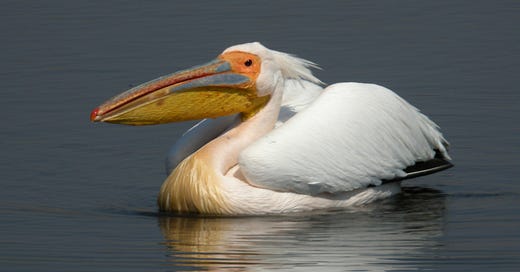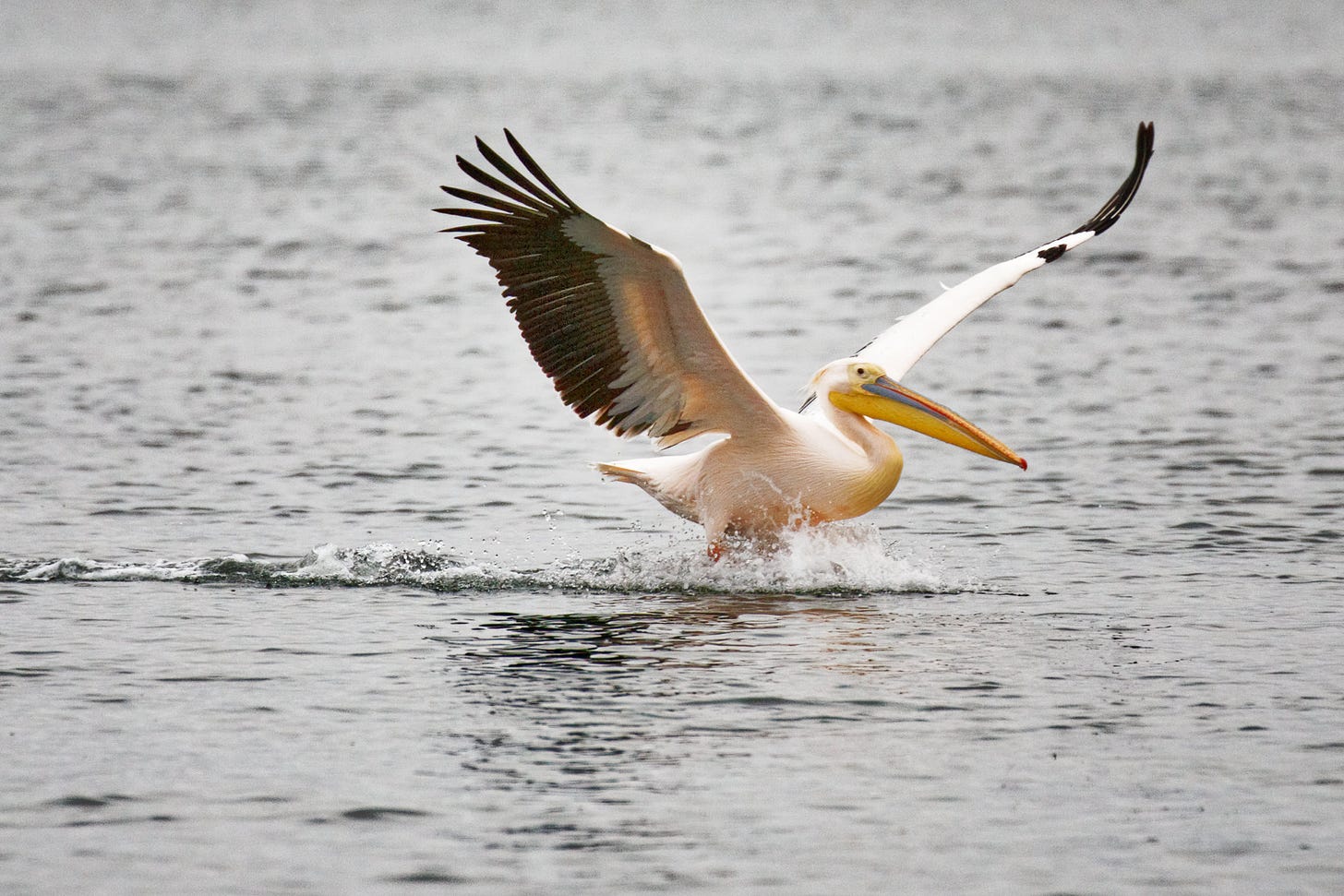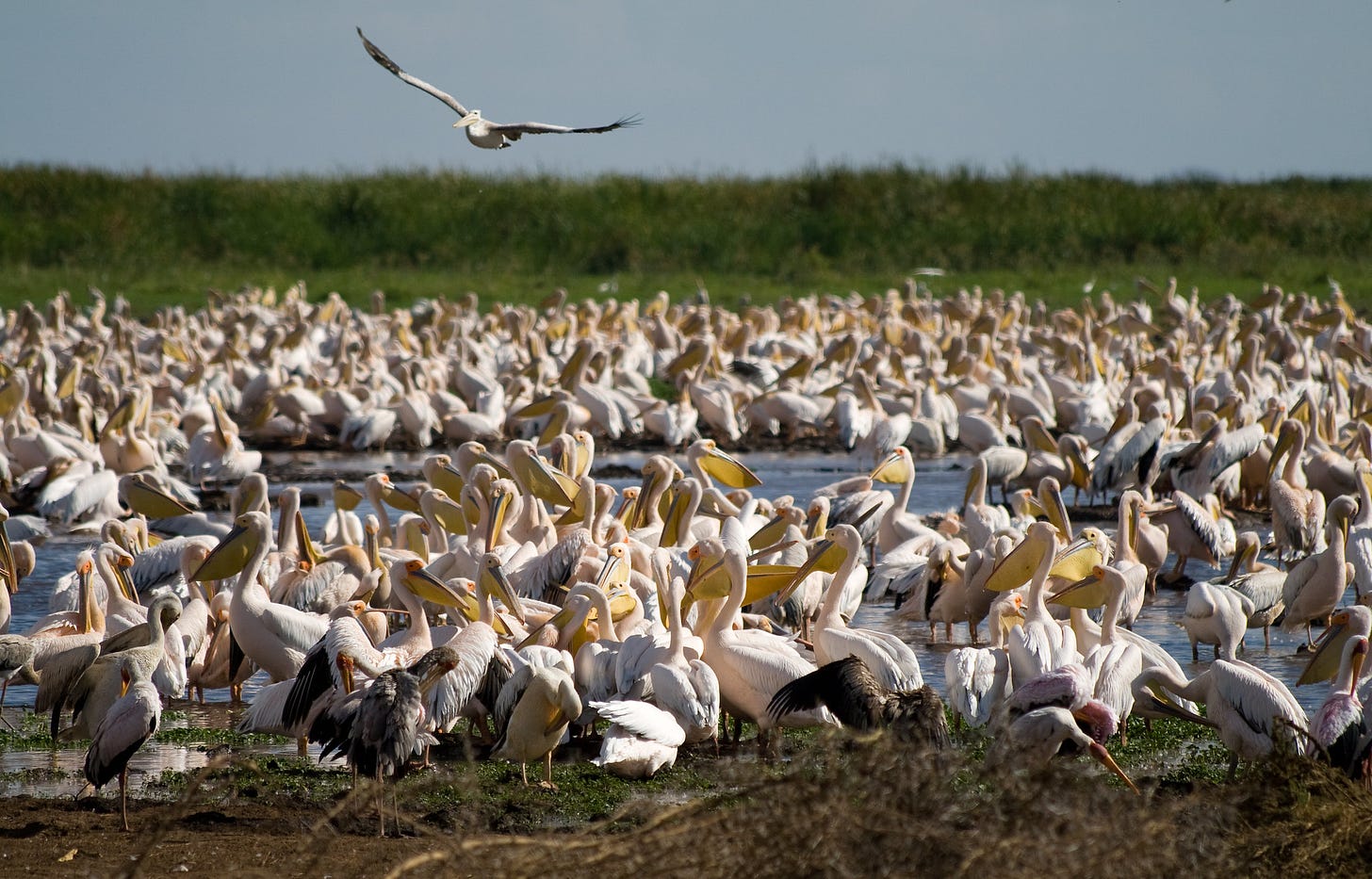First things first—check out our fancy new banner! Bird of the Week now has its own branding™ courtesy of our resident art genius Sam Grasso. Look at it, it’s so good!!!! (And it makes me want a Discourse Blog stamp—our little starling is clearly perfect for postage.)
OK, onto the main show: today’s bird. It’s big, it’s bold, it’s………….THE GREAT WHITE PELICAN.
Helllllll yeah. I sometimes lose track of the various kinds of birds we’ve highlighted in this feature, but a couple of weeks ago, partner-in-bird Caitlin relayed a troubling message from none other than her father, Michigan Journalism Hall of Fame inductee John Schneider. The message, in short: why has Bird of the Week never written about a pelican??!
Mr. Schneider, apart from being a highly decorated journalist, is also a serious and astute observer of bird-related issues. Indeed, you may recall that we featured one of his favorite birds, the Kirtland’s Warbler, back in our very first edition of BOTW, along with his sensible request that it be made the state bird of Michigan. (Michigan has yet to comply, but the worthiest battles often take a long time to win.) So when he points out a deficiency of this kind in our bird coverage, I have no choice but to take it very seriously. And thus, our belated but much-needed look at our very first pelican. And what a pelican!
The great white is also known as the rosy pelican, or simply the white pelican, but I am including the “great” part because I think more great things should have “great” in their names at all times. (And luckily, this is something you can use the phrase “great white” about and it doesn’t end with Richard Spencer sending you an approving note.) All pelicans are big, but the great white pelican is big big—in fact, only the dalmatian pelican is bigger among all of the pelicans. How big are we talking here? Well, according to Animalia, the biggest great whites can top out at 180 centimeters in length. That’s 5’11’’! That’s substantially taller than a lot of humans (for instance, me). Now, granted, not all great white pelicans are that tall, but still! Wow! And the wingspan??? Look at this.
Great whites can have wingspans of up to 12 feet. That’s right: get two six-foot-tall people to lie head-to-toe next to each other and that’s how long a great white pelican’s wingspan is. Unreal! And I haven’t even mentioned its gigantoid bill.
So what does a great white pelican do with all of this impressive size? It lives its life, of course. That life takes place all over the world. Seriously, this bird is everywhere. Look at this exhaustive compendium from the University of Michigan (shoutout to Caitlin and John again!) Museum of Zoology :
During the nonbreeding season, it can be found mostly in Africa and parts of Saudi Arabia along the Red Sea. It can be found as far south as Cape Town, South Africa. The range of the pelican is spread from the west coast of Senegal to the east coast of Ethiopia, through Africa. It can be found as far north as Egypt, Israel and Jordan along the Mediterranean Sea. The great white pelican can also be found sporadically throughout parts of India, Afghanistan, Iran, Pakistan, and Bangladesh.
During the breeding season, it can be found in areas of Europe and Central Asia. The pelican can be found as far west as Montenegro and as far east as Kyrgyzstan. Great white pelicans range as far north as Kazakhstan, and as far south as Israel. The pelican also has been found on the east coast of Romania and Bulgaria along the Black Sea during breeding season. Great white pelicans have been known to breed in parts of Turkey, northeastern Uzbekistan, the western half of Armenia, and the east coast of Azerbaijan.
Pelicans are highly sociable birds. They form huge colonies where they all hang out together, like this one:
These colonies are also apparently one of the only places you will hear pelicans making any sounds. Apart from that, they are mostly silent when they’re not in their packs, or eating. The great white makes a kind of mooing sound, which you can hear in this informative video.
Speaking of eating…the other thing pelicans are into is fish. Fish, fish, and more fish, that’s what a pelican wants. Luckily, it’s evolved to be the perfect fish collection machine.
The first trick the great white uses is something called a gular pouch, which all pelicans have. Here’s the National Park Service to explain:
[The gular pouch is] a thick layer of skin located on the lower mandible and connected to the throat - this is a gular pouch. The bird uses this flap of skin to scoop fish out of the water, to hold its catch like a dinner plate of regurgitated fish for its chicks, and even to cool itself on a hot day! Many water birds (such as pelicans and cormorants) have this peculiar body part, including tropical water birds like gannets, frigatebirds, and anhingas. The pelican's gular pouch is unique in that it can hold three times more than its stomach. It can hold three gallons and up to 24 pounds in that supple sack of skin! Amazing!
Couldn’t have said it better myself: amazing!
The second advantage great white pelicans have is their love of fishing in tightly clustered groups. They move together almost as a single unit as they skim the surface of the water for their meal. (Other pelican species have different methods.) Here’s a video of that:
The amount of space they cover together is wild. And here’s an even more spectacular video of a lone great white pelican using one of its other important features, exceptional eyesight, to spot a fish from what seems like an eternity away and expertly nab it. Seriously, check this out:
PS: don’t ever toss pelicans fish scraps or fish bones, it can seriously harm them!!! In fact, just stay away from feeding them altogether—the videos above should show that they’ve got this covered.
I’m going to close out with just a video of great white pelicans flying, because it’s marvelous:
OK, that’s all for now! Yay for the great white pelican, and all pelicans! And remember, as always: you can check out our complete Bird of the Week list here, and get in touch with your bird suggestions at hello@discourseblog.com. Until next time!!!!









The (Other) Website That Shall Not Be Named, in the Before Times, ran a great explainer of the awesomeness of Brown Pelicans when the New Orleans basketball team adopted it as their name:
https://deadspin.com/fuck-you-pelicans-are-awesome-a-defense-of-the-nbas-b-5966336
<shudder>
these things are terrifying. I first encountered them in Florida during the pandemic. My wife described them as "unsettlingly large" and they are. They have a muppet-ish quality that really strikes fear into one's heart.